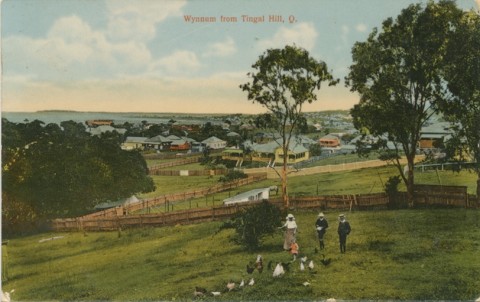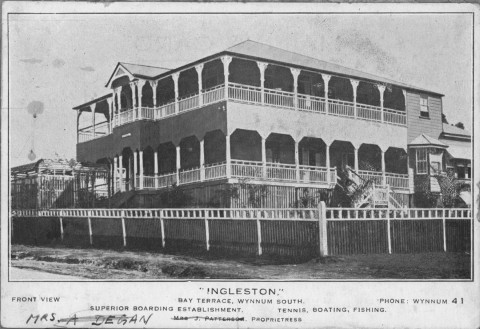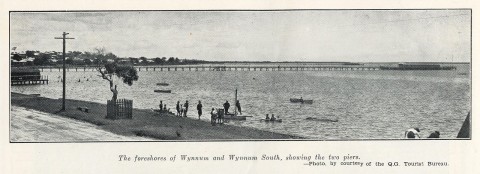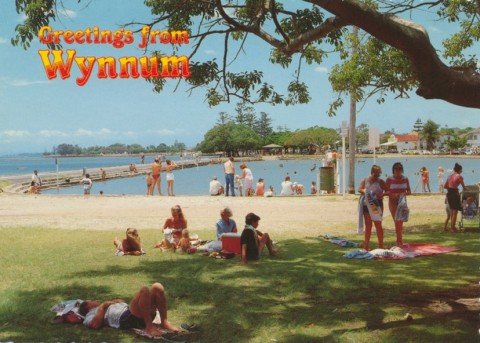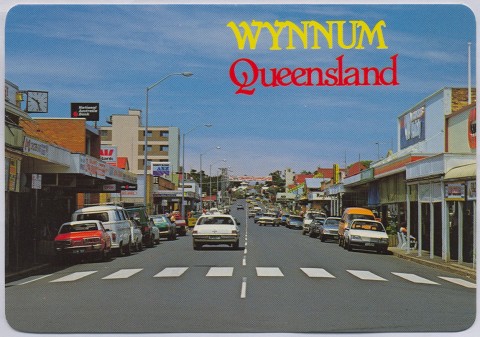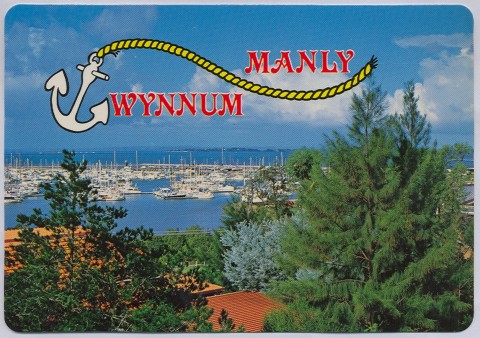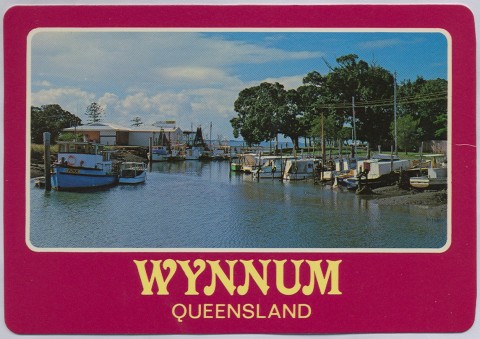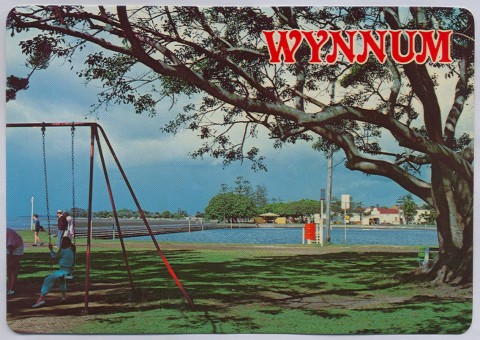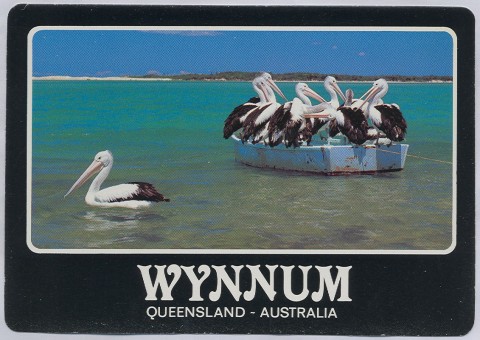Wynnum, a residential suburb on Moreton Bay south of the mouth of the Brisbane River, is 15 km east-north-east of central Brisbane. It is thought that the name was derived from an Aboriginal word describing the screw pine, a popular name for the Pandanus species, most of which are found in coastal, tidal stream or swampy environments. Unrelated to true pines or other conifers, the seed fruits were sometimes used by Aborigines for food.
Land sales first occurred in Wynnum in 1860. A track was formed in 1881 to the Hastings (later Wynnum) hotel north of the outlet of Wynnum Creek. Local government came under the Bulimba division which in 1888 was divided into the Balmoral division, and the Kianwanah division based at Wynnum. The following year the railway from Brisbane to Cleveland, running through Wynnum, was completed, coinciding with the opening of the Waterloo Bay Hotel. A Methodist church was built in 1890 and the Wynnum North and Wynnum Central State schools began in 1882 and 1896. In 1892 the divisional board's name was changed to Wynnum. (It became a shire in 1902 and a town in 1913.)
In 1901 Miss Alice Greene, formerly a teacher at Rockhampton Girls' Grammar, and her sister Anne opened Moreton Bay High School for Girls on a select site overlooking the shoreline. The school building was spacious and modern, beginning with six boarders and twenty day students. It built up a fine reputation, but in 1945, when Alice was in her early 80s, she presented the School to the Methodist church and it subsequently became incorporated as Moreton Bay College. Her brothers Samuel and John served as Mayors of Wynnum and both subsequently served on the Brisbane City Council, John as Lord Mayor from 1931 to 1934.
MARINE SUBURB
Wynnum was on the way to claiming some distinction as a marine suburb, as well as a place of relaxation and recreation. In addition to a foreshore esplanade the divisional board reserved space along the Wynnum Creek, naming it Kitchener Park in recognition of the visit of Lord Kitchener to advise on Australia's defences. In 1910 the division was proclaimed a town, with municipal boundaries enclosing 27 sq km which extended to Tingalpa, south to Lota and north to Lytton and Bulwer Island. The municipality could thus accommodate the Wynnum and Manly Agricultural, Horticultural and Industries Society (1916), which in 1919 held its first show on the Memorial Park, a space reserved in memory of those who had served in the war.
The Wynnum and Manly School of Arts opened in Bay Terrace in 1913. The Terrace became the district's main shopping area, situated in Wynnum South. A local gas works (1914) supplied public lighting and reticulated gas to householders and shops. Lighting of a different kind arrived with the opening of the Star picture theatre, Wynnum South, in 1915, which in a few years claimed 'to present only the best first release productions, direct from leading city theatres'. By the 1920s Wynnum had several churches, a bowling club, a golf course on Lovekin's Paddock, next to Kitchener Park, and a comprehensive shopping centre. Irvine and Sons, Wynnum's new emporium, was as up-to-date as any in a Brisbane suburb, supplying drapery, clothing, groceries, hardware, crockery, footwear and furniture. Gas lighting gave way to reticulated electricity in 1923. Urban Wynnum came within the State Government definition of greater Brisbane, which subsumed the municipality in 1925. Two years before, it had been connected to the Metropolitan Water and Sewerage Board for its water. The township was expanding beyond its early compact form, and the Wynnum West Primary School opened in 1922.
The Catholic church became a significant presence in Wynnum. Mount Carmel convent in Bay Terrace was built in 1915, next to Guardian Angels primary school (1914) and the massive Nazareth House convent and orphanage on a commanding position in Wynnum North Road was built in 1924. Both convents are heritage-listed.
Despite claims to be a bayside suburb, with esplanades and a landscaped foreshore, beach bathing was scant. A saltwater wading pool was built near the jetty in 1932, which also had a deeper-water baths at its end. An artificial Pandanus Beach was installed next to the jetty in 1987, complementing the wading pool and a children's playground.
Wynnum High School, positioned within reach of Wynnum West and Manly, as well as Wynnum, was opened in 1942. A second high school, Wynnum North (1964), was needed as residential space spread westwards. The Bay Terrace shopping centre and its adjoining streets proved to be impregnable to a drive-in development, and Wynnum Plaza was instead laid down along the main Brisbane road, Wynnum West, in 1980. It began with a modest twenty or so shops, expanding to sixty in 1998.
Construction began in 2015 on a new public library on the site of the former Wynnum Central State school in a joint venture between the City of Brisbane Investment Corporation and a large commercial retailer. Scheduled to open in 2016, the project would also relocate four timber school buildings on the Wynnum school site, purchased by the Brisbane City Council in 2012, for use by community groups.
Wynnum's census populations have been:
| Area | Census Date | Population |
|---|---|---|
| Wynnum | 1891 | 683 |
| 1911 | 2320 | |
| 1921 | 8357 | |
| 1933 | 12,905 | |
| 1954 | 18,479 | |
| Wynnum and Lota | 1961 | 22,007 |
| 1971 | 24,064 |
The statistical area thereafter comprised several subdivisions, and the three most closely approximating 'Wynnum' of the 1950s were:
| 2001 | 2006 | 2011 | |
|---|---|---|---|
| Lota | 2743 | 2980 | 3255 |
| Manly | 3598 | 3815 | 3702 |
| Wynnum | 10,935 | 11,719 | 12,229 |
| Total | 17,276 | 18,514 | 19,186 |
Manly West and Wynnum West were 11,195 and 11,745 respectively, giving a total population for 'greater Wynnum' of 42,126 in 2011.
Brisbane Centenary Official Historical Souvenir, Brisbane, Brisbane Centenary Celebrations Committee, 1924
Lota, Manly, Manly West and Wynnum West entries
